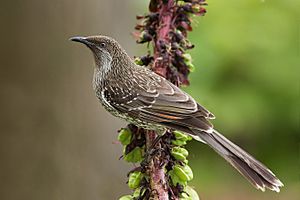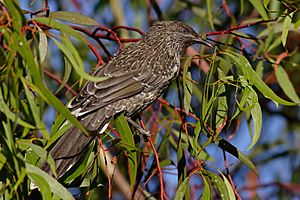Little wattlebird facts for kids
Quick facts for kids Little wattlebird |
|
|---|---|
 |
|
| Conservation status | |
| Scientific classification | |
| Genus: |
Anthochaera
|
| Species: |
chrysoptera
|
The little wattlebird (Anthochaera chrysoptera) is a fascinating bird from the honeyeater family. It's also known as the brush wattlebird. You can find these birds living along the coasts and nearby areas of south-eastern Australia.
Contents
About the Little Wattlebird
The little wattlebird was first officially described by a bird expert named John Latham in 1801. He gave it the scientific name Merops chrysoptera. Today, it's placed in a group of birds called Anthochaera.
The name Anthochaera comes from ancient Greek words. Anthos means 'flower' or 'bloom', and khairō means 'enjoy'. So, it's like 'flower-enjoyer'! The second part of its scientific name, chrysoptera, also comes from ancient Greek. Khrysos means 'gold' and pteron means 'wing'. This means 'golden-winged'.
There are three main types, or subspecies, of the little wattlebird:
- A. c. chrysoptera: Found in eastern and south-eastern Australia.
- A. c. halmaturina: Lives on Kangaroo Island in South Australia.
- A. c. tasmanica: Found in Tasmania.
What Does It Look Like?
The little wattlebird is a medium to large honeyeater. It's the smallest bird in its group, the Anthochaera wattlebirds. It looks a bit like the yellow wattlebird and the red wattlebird.
One interesting thing about the little wattlebird is that it doesn't have the fleshy growths called wattles that other wattlebirds have. Young wattlebirds look a bit duller than adults. They have less streaking on their feathers and their eyes are browner.
These birds make many different sounds! You might hear a loud cookay-cok or a rough fetch the gun. They also make softer, musical sounds like yekkop, yekkop. When they are alarmed, they might make a sharp kwock or shnairt!.
Where Do They Live?
Little wattlebirds live in many different places. They like woodlands with banksia and eucalypt trees. You can also find them in heathlands, tea-tree scrub, and sandy heath areas. They sometimes live in lantana thickets, wild tobacco plants, and even in parks and gardens near people.
Behaviour and Life Cycle
Reproduction
Little wattlebirds usually breed between June and December. The female bird builds the nest. It's a loose, messy cup made of twigs and lined with soft, shredded bark. She usually places the nest in the fork of a tree. This could be a banksia, tea-tree, or eucalypt sapling. The nest is typically 1 to 10 meters (about 3 to 33 feet) high.
The female lays 1 or 2 eggs. These eggs can be spotted red-brown, purplish-red, or even salmon-pink. The female sits on the eggs to keep them warm until they hatch. Once the chicks are born, both parents work together to feed and care for them.
Feeding
Little wattlebirds love to eat nectar. They have a long tongue with a brush-like tip, which helps them reach deep inside flowers. Besides nectar, they also eat insects, berries, and some seeds. They usually find their food while perched on a branch. However, they can also catch insects in the air! These birds might feed alone or in small groups.
See also
 In Spanish: Mielero alirrufo para niños
In Spanish: Mielero alirrufo para niños




